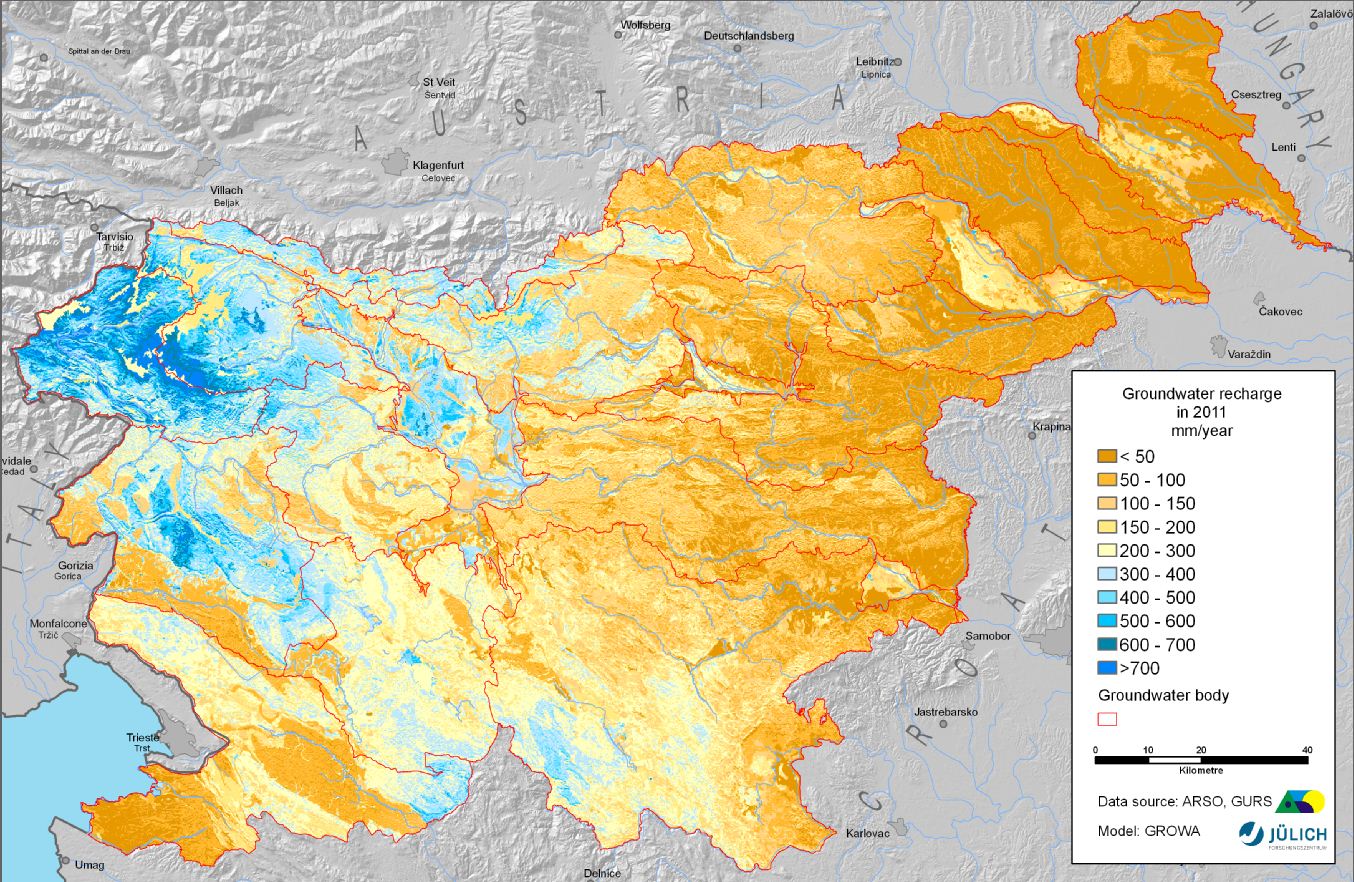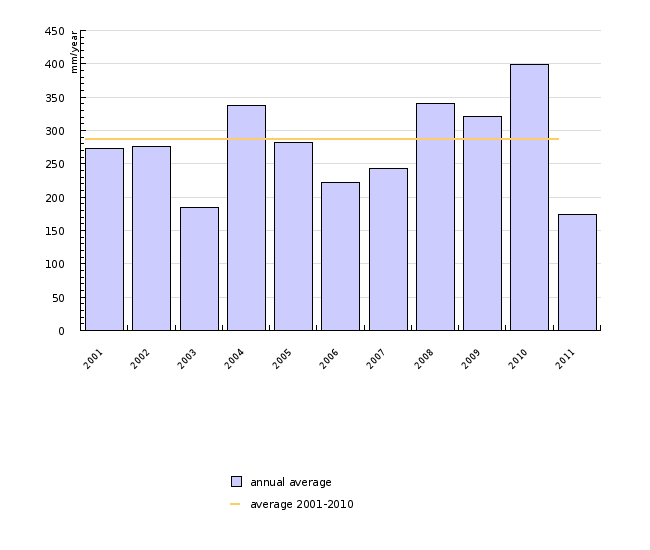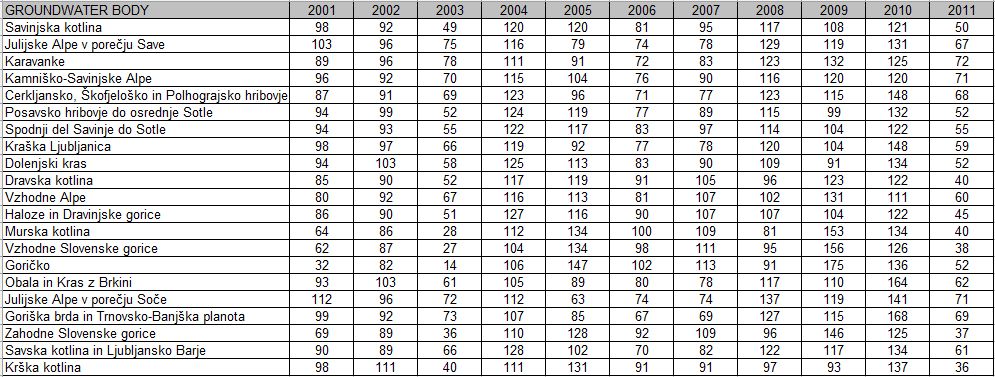[VD15] Groundwater recharge

Key message

Total renewable groundwater quantity in shallow aquifers of Slovenia was in 2011 markedly below the 2000 to 2010 average. Moreover, it was even below the groundwater quantity of 2003, the most dry year of the last decade.
Definition
This indicator is represented by annual groundwater recharge of shallow aquifers of groundwater bodies in all Slovenia (VD15-1 and VD15-2), as well as by the indices of annual recharge of shallow aquifers of individual groundwater bodies (VD15-3).
Groundwater is replenished by aquifer recharge, being a complex process of water inflow into the saturated zone. Recharge is being assessed by the regional water balance model for all Slovenia, expressed in water height (mm). Recharge for individual groundwater bodies for the years 2001 to 2011 is shown as annual recharge index (2001 to 2010 = 100).
Charts
Groundwater recharge modelling by water balance model GROWA-SI (Forschungszentrum JÜLICH, Slovenian Environment Agency), 2012
Groundwater recharge modelling by water balance model GROWA-SI (Forschungszentrum JÜLICH, Slovenian Environment Agency), 2012
| 2001 | 2002 | 2003 | 2004 | 2005 | 2006 | 2007 | 2008 | 2009 | 2010 | ||
|---|---|---|---|---|---|---|---|---|---|---|---|
| annual average | mm/leto | 273 | 277 | 184 | 337 | 282 | 222 | 243 | 340 | 321 | 400 |
| average 2001-2010 | mm/leto | 288 | 288 | 288 | 288 | 288 | 288 | 288 | 288 | 288 | 288 |
| 2011 | |||||||||||
| annual average | mm/leto | 174 | |||||||||
| average 2001-2010 | mm/leto | 288 |
Groundwater recharge modelling by water balance model GROWA-SI (Forschungszentrum JÜLICH, Slovenian Environment Agency), 2012
Goals
Groundwater is traditionally the major source of drinking water in Slovenia, contributing about 97% of all water supply quantity in the country. Slovenian groundwater sources exhibit high regional and seasonal variability, and lately there is a tendency of more frequent and more pronounced droughts. Since there is to be expected probable future crisis in water supply, the indicator is gaining on importance. Main contributions of the method used in idicator development, as of the indicator itself, are as follows:
- to improve groundwater quantity assessment, as well as forecasting and alarming in case of hydrologic extremes, e.g. hydrologic drought in aquifers;
- to identify those aquifer areas prone to frequent hydrologic droughts;
- to improve groundwater management in the fields of drinking water supply and protection of groundwater dependent aquatic ecosystems.
Comment
Groundwater recharge shows big variability both in time and in spatial distribution. The recharge variability from year to year has been the highest in groundwater bodies of NE Slovenia (Figure VD15-3) where the recharge ammount in the year 2011 was the lowest (Figure VD15-1). In Julian Alps of NW Slovenia, with highest groundwater recharge rate, the aquifer recharge in the last decade has been more than tenfold of that in Goričko of NE Slovenia. Apart from this highly pronounced spatial variability, the index of annual average groundwater recharge shows in 2001 to 2011 period a big variability range (Figure VD15-3), indicating a high sensitivity of shallow aquifers regarding groundwater quantity.
Total groundwater quantity in shallow aquifers of Slovenia was in 2011 markedly below the 2001 to 2010 average (Figure VD15-2). In 2011 there was the highest deviation from 2001 to 2010 average in groundwater bodies of Krška kotlina, Dravska kotlina, Murska kotlina and Vzhodne Slovenske gorice (I 11/01-10 < 40); somewhat less pronounced was a deviation in the groundwater bodies of Alpine area (I 11/01-10 > 70) (Figure VD15-3).
Methodology
Targets and legislative base:
Targets are set in Slovenian national environment policies, while the legislative base is founded in EU water related legislation transposed to Slovenian law system, as well as in relevant Slovenian national legislation.
Data source: Assessments based on results of regional water balance model GROWA-SI (Forschungszentrum JÜLICH, Slovenian Environment Agency); meteorological and hydrological data base of Slovenian Environment Agency.
Data managers: Dr Jože Uhan (Head of Hydrogeological Analysis Division), Dr Mišo Andjelov (Project Manager of National Water Balance Modelling); Slovenian Environment Agency, Hydrology and State of the Environment Office.
Date of data capture for indicator: Indicator updating for the year 2011 was done in May 2012, by data capturing from Slovenian Environment Agency data base of meteorological and hydrological data.
Methodology and frequency of data acquisition for indicator: Indicator is updated yearly.
Methodology of data processing: Renewable groundwater quantity has been assessed by regional water balance model GROWA-SI (Forschunszentrum JÜLICH, Slovenian Environment Agency). Model takes into account variables concerning climate, geology, soil type, land use, topography and hydrogeology, and by assessing real evapotranspiration it leads to calculation of the components of annual runoff. Model has been calibrated on hydrological data measured in 1971 to 2000 reference period through the program of national water monitoring, safeguarding data quality according to ISO 9001:2000. Water balance component of groundwater runoff in the model is annual groundwater recharge in mm, shown as spatial distribution in grid resolution of 100x100 metres on the map (Figure VD15-1), as well as aggregated annual value for all Slovenia shown in hystogram (Figure VD15-2). Index In/01-10 of groundwater recharge for the year n (Figure VD15-3), based on the average for 2001-2010, is calculated by equation I n/01-10 = Xn*100 / X01-10











